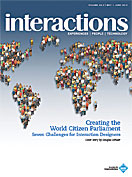Authors:
Annalu Waller
Augmentative and alternative communication (AAC) refers to strategies and techniques used by individuals who experience communication difficulties because they have little or no functional speech. AAC can support (i.e., augment) speech or it can provide a replacement (i.e., act as an alternative) for spoken communication. In addition to supporting expressive communication in adults and children, AAC can also support the development of language and even natural speech in children. People who use AAC are a diverse group, as communication disorders can result from congenital disability (e.g., cerebral palsy, autism, Down Syndrome, and developmental delay), acquired disability (e.g., stroke, also…
You must be a member of SIGCHI, a subscriber to ACM's Digital Library, or an interactions subscriber to read the full text of this article.
GET ACCESS
Join ACM SIGCHIIn addition to all of the professional benefits of being a SIGCHI member, members get full access to interactions online content and receive the print version of the magazine bimonthly.
Subscribe to the ACM Digital Library
Get access to all interactions content online and the entire archive of ACM publications dating back to 1954. (Please check with your institution to see if it already has a subscription.)
Subscribe to interactions
Get full access to interactions online content and receive the print version of the magazine bimonthly.






